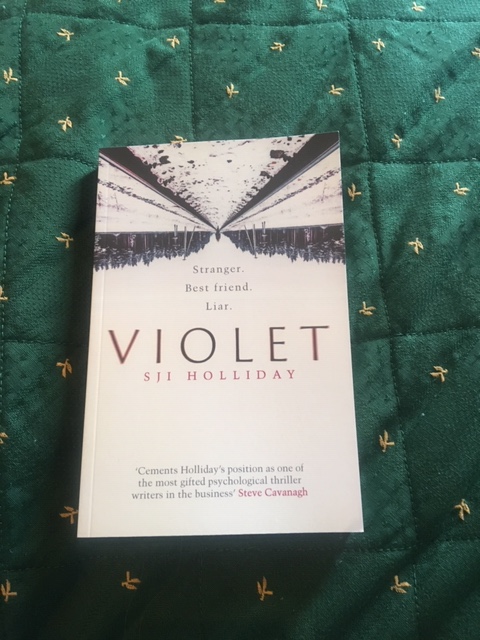Harrogate is a fabulous festival. Even more so when you get handed a proof of Violet by SJI Holliday. So a big thank you to Karen Sullivan! I don’t always get the chance to read every single book an author has written but I have with Susi. Whether it’s her long-suffering police officer, Davie Gray in her Banktoun trilogy, or her ghost-busting, The Lingering, or her Christmas novel, The Deaths of December – I’ve read them all. So it was with baited breath that I jumped into Violet.
The Blurb
Carrie’s best friend has an accident and can no longer make the round-the-world trip they’d planned together, so Carrie decides to go it alone.
Violet is also travelling alone, after splitting up with her boyfriend in Thailand. She is also desperate for a ticket on the Trans-Siberian Express, but there is nothing available.
When the two women meet in a Beijing Hotel, Carrie makes the impulsive decision to invite Violet to take her best friend’s place.
Thrown together in a strange country, and the cramped cabin of the train, the women soon form a bond. But as the journey continues, through Mongolia and into Russia, things start to unravel – because one of these women is not who she claims to be…
A tense and twisted psychological thriller about obsession, manipulation and toxic friendships, Violet also reminds us that there’s a reason why mother told us not to talk to strangers…

My Review
Recently there was a TV programme on BBC2 where people took part in a race from London to Singapore using various forms of transport except airplanes. They were in pairs and although it was interesting to see the choices they made in terms of transport and routes (they had limited money), the most fascinating part was how well they got on. Or didn’t. The final four teams were two sets of friends, a father and son, and a husband and wife. There was some bickering and sulking but they all managed to resolve any differences. Of course, though, they knew each other well. But what if you travelled with a stranger?
They say reading a book is like going on a journey and SJI Holliday literally does this in her new novel, Violet. Carrie and Violet are both at loose ends. Carrie’s friend had an accident so couldn’t make the trip of a lifetime and Violet has recently split with her boyfriend. It makes perfect sense for Violet to take the spare ticket for the Trans-Siberian Express. Doesn’t it?
The narrative is from Violet’s point of view but we hear from Carrie through her emails to Laura, the friend who couldn’t make the trip. I’ve never travelled like this but having watched the TV programme, there’s an intensity in travelling, especially when you’re stuck on a train for days on end, and that comes across so well. There’s tension throughout as we’re unsure who to trust.
Susi always has fantastic descriptions and her prologue sets us up for a creepy, gripping story. Far from being the trip of a lifetime, the journey becomes the holiday from hell. There are plenty of twists and turns as we learn more about Carrie and Violet. Or we think we do. I love the fact that I was never quite sure where things were going or what was going to happen. It’s real ‘edge of the seat’ stuff. In true SJI Holliday form, we don’t know the whole story until the very end. And even then she leaves us wanting more.
My favourite part of the book though is a little tie-in with The Lingering. I’m not going to say any more than that and leave it for you to spot.
Having never travelled like this before, I’m not sure if I want to now. But if I do, I’m definitely going with someone I know really well!
Violet is already available as an e-book and will be published in paperback a month today on Thursday 14th November. For more details click here.
The Author

S.J.I. (Susi) Holliday grew up in East Lothian, Scotland. A life-long fan of crime and horror, her short stories have been published in various places, and she was shortlisted for the inaugural CWA Margery Allingham prize.
She has written three crime novels set in the fictional Scottish town of Banktoun, which are a mix of police procedural and psychological thriller. They are: Black Wood, Willow Walk and The Damselfly – all featuring the much loved character, Sergeant Davie Gray.
Her serial killer thriller The Deaths of December (written as Susi Holliday), featuring Detective Sergeant Eddie Carmine and Detective Constable Becky Greene was a festive hit in 2017.
Her spooky mystery The Lingering was released in September 2018.
Her latest book Violet – a psychological thriller set on the Trans-Siberian Express is out in September 2019.
You can find out more at her website: http://www.sjiholliday.com and on Facebook and Twitter @SJIHolliday. Sign-up for updates and giveaways here: http://eepurl.com/beHpez

 I’m thrilled to be taking part in the tour for A House of Ghosts to celebrate the paperback being published. Thank you to Tracy Fenton and Zaffre Books for inviting me to take part. I have A House of Ghosts in hardback and it’s so beautiful. I’m glad to see that the paperback looks just as good. I reviewed the book last year and you can read my review
I’m thrilled to be taking part in the tour for A House of Ghosts to celebrate the paperback being published. Thank you to Tracy Fenton and Zaffre Books for inviting me to take part. I have A House of Ghosts in hardback and it’s so beautiful. I’m glad to see that the paperback looks just as good. I reviewed the book last year and you can read my review 

















